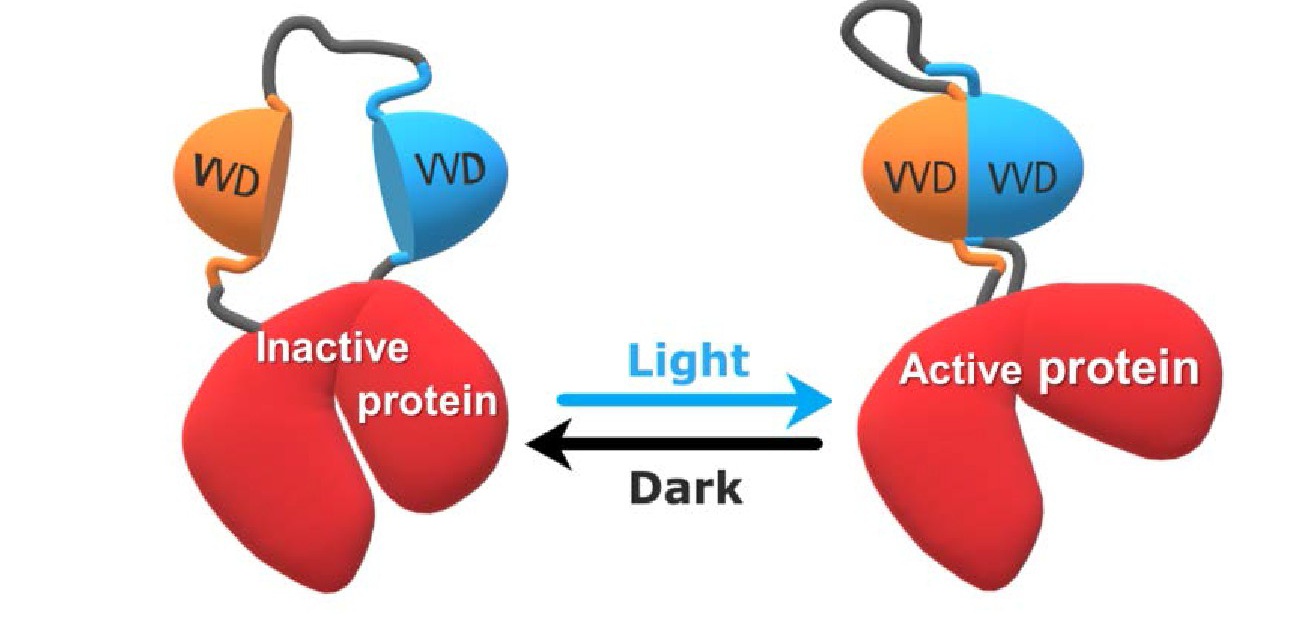As an enzyme designer, our company is expert at creating allosterically controlled enzyme switches. Creating allosterically controlled enzyme switches in enzyme design is a cutting-edge approach that offers significant potential in various fields, including biotechnology, medicine, and synthetic biology. Allosteric switches allow for precise control over enzymatic activity by modulating the conformation and function of enzymes through the binding of specific ligands or environmental cues. With cutting-edge scientific expertise, state-of-the-art facilities, and a deep understanding of preclinical drug development, we have the ability to design and create allosterically controlled enzyme switches for our customers.
 Fig. 1. In the dark, tandemly connected VVD photoreceptors disrupt the catalytic activity of the protein, but dimerization in response to blue light restores it. (Shaaya, M., et al., 2020)
Fig. 1. In the dark, tandemly connected VVD photoreceptors disrupt the catalytic activity of the protein, but dimerization in response to blue light restores it. (Shaaya, M., et al., 2020)
Diverse Allosterically Controlled Enzyme Switches Creating Services
Our expertise and capabilities allow us to deliver customized solutions using different types of allosteric switches. Here are some of the types of allosterically controlled enzyme switches creating services we provide:
- Allosteric activator/inhibitor design: We can design and engineer allosteric switches that respond to specific small molecules or ligands, acting as either activators or inhibitors of enzymatic activity. Whether you require switches that enhance enzyme function or switches that dampen enzymatic activity, we can tailor the design to your requirements.
- Effector-responsive switch development: Our services encompass the creation of effector-responsive switches that are regulated by specific molecules present in the cellular environment. By understanding the signaling pathways or metabolic networks involved, we can engineer switches that respond to the presence or absence of target effectors, enabling precise control over enzyme activity.
- Ligand-dependent switch engineering: If you require switches that respond to the binding of specific ligands, we can design and engineer ligand-dependent allosteric switches. These switches are customized to recognize and respond to the presence of desired ligands, resulting in the activation or inhibition of enzymatic activity.
- Temperature-sensitive switch design: Our expertise extends to temperature-sensitive switches that undergo conformational changes in response to temperature variations. By harnessing the thermosensitivity of enzymes, we can engineer switches that enable precise control over enzymatic activity based on temperature cues.
- pH-responsive switch development: We offer services for the design and creation of pH-responsive switches that respond to changes in pH levels. These switches can be tailored to specific pH ranges and enable the modulation of enzyme activity based on the pH conditions in the target environment.
- Light-sensitive switch engineering: Our capabilities include the development of light-sensitive switches, also known as optogenetic switches, which utilize light as a stimulus to control enzymatic activity. We can engineer switches incorporating light-sensitive proteins or chromophores that undergo conformational changes upon exposure to specific wavelengths of light.
Advantages of Our Services
- Enhanced Functionality: Allosterically controlled enzyme switches can greatly enhance the functionality of enzymes. By utilizing our services, you can introduce regulatory elements that allow for precise control over enzymatic activity. This opens up new possibilities for enzyme applications, such as fine-tuning catalytic activity, enabling on/off switching, or modulating enzyme activity in response to specific cues.
- Customized Control Mechanisms: We understand that different applications require different modes of control. Our services allow for the customization of allosterically controlled enzyme switches based on your specific requirements. Whether you need switches activated by small molecules, effector molecules, temperature, pH, light, or other stimuli, we can design and engineer switches that provide the desired control mechanisms.
- Improved Specificity and Selectivity: Allosterically controlled enzyme switches can enhance the specificity and selectivity of enzymatic reactions. By harnessing the power of allosteric regulation, we can engineer switches that respond only to specific regulatory cues, ensuring precise control over enzyme activity without interfering with other cellular processes. This specificity and selectivity are crucial in applications where high target specificity is required, such as in medical diagnostics or biocatalysis.
- Versatility and Flexibility: Our services offer versatility and flexibility in enzyme design. We can engineer allosterically controlled switches for a wide range of enzymes and applications. Whether you require switches for natural enzymes or tailor-made switches for engineered enzymes, we can accommodate your needs. This versatility allows for the design of switches suitable for various enzyme classes, including oxidoreductases, hydrolases, transferases, and more.
- Accelerated Design and Optimization: Our expertise and advanced tools enable the rapid design and optimization of allosterically controlled enzyme switches. We employ computational modeling, structural analysis, and biochemical assays to iteratively refine the switches and improve their performance. This accelerated design and optimization process saves time and resources, allowing you to expedite your enzyme design projects.
- Application Support: We provide comprehensive support throughout the enzyme design process. Our team of experts can assist you in determining the best allosterically controlled switch design for your specific application. We offer consultation, feasibility studies, and guidance to ensure that the switches meet your functional requirements and align with your project goals.
- Integration with Existing Systems: Our services are designed to enable seamless integration of allosterically controlled enzyme switches with existing systems or workflows. Whether you are incorporating the switches into a biotechnological process, a biosensor platform, or a therapeutic application, we can work with you to ensure compatibility and optimize the performance of the switches within your specific system.
Reference
- Shaaya, M.; et al., Light-regulated allosteric switch enables temporal and subcellular control of enzyme activity. Elife. 2020. 9.

































 Fig. 1. In the dark, tandemly connected VVD photoreceptors disrupt the catalytic activity of the protein, but dimerization in response to blue light restores it. (Shaaya, M., et al., 2020)
Fig. 1. In the dark, tandemly connected VVD photoreceptors disrupt the catalytic activity of the protein, but dimerization in response to blue light restores it. (Shaaya, M., et al., 2020)